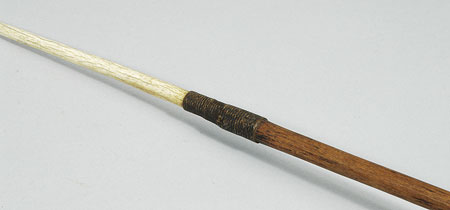Accession Number:
1919.13.20
Country:
Sudan
Region:
[Southern Sudan]
Cultural Group:
?Dinka
Date Made:
By 1919
Materials:
Animal Bone , Wood Plant , Animal Hide Skin , Animal Tail
Process:
Carved , Polished , Socketed , Covered , Tooled
Dimensions:
Total L = 2137, diam shaft = 16.7; sheath L = 74, diam = 20.2; point L = 314, maximum diam = 15.2 mm [RTS 3/1/2005].
Weight:
351.4 g
Other Owners:
Bought by Louis Colville Gray Clarke at Stevens Auction Rooms on 11th March 1919 (lot 362) and donated to the Pitt Rivers Museum the same year [RTS 5/8/2005].
PRM Source:
Louis Colville Gray Clarke
Acquired:
Donated March 1919
Collected Date:
By March 1919
Description:
Spear consisting of a narrow, straight point with an oval section made from a light cream coloured giraffe's leg bone (Pantone 7401C).
The base of this rests against the top of a long narrow shaft of orangey brown wood (Pantone 730C) with a slightly oval section; the lower body is slightly kinked, and it tapers to a point at the base.
Both parts have been polished.
The junction between them is covered with a short cylindrical sheath cut from a section of animal's tail with the hair removed; this was stretched over the body whilst wet and then shrunken in place, with the surface strongly tooled in regular rows around the circumference to give it a textured pattern made of angled, lentoid-shaped impressions.
The sheath is mid brown in colour (Pantone 730C) with some darker discolouration.
The spear is complete, but has a short split in the shaft just below the sheath area.
It has a weight of 354.1 grams, and is 2137 mm long with a shaft diameter of 16.7 mm.
The point measures 314 from its tip to the top of the sheath and has a maximum width of 15.2 mm, while the sheath itself is 74 mm long and has a diameter of 20.2 mm.
Bought by Louis Colville Gray Clarke at Stevens Auction Rooms on 11th March 1919 (lot 362) and donated to the Pitt Rivers Museum the same year; the original collector is not known. It is said to be a Dinka object from the 'White Nile'. Throughout the twentieth century the term ‘White Nile’ has been used to denote an administrative district immediately south of Khartoum. However at the time this object was collected the term was also used more loosely to refer to the Bahr el Abiad and Bahr el Jebel rivers, or the areas immediately around them, and association with the Dinka suggests this is probably the case here.
For other spears in the collection tipped with giraffe bone points, see 1936.10.4-5 (Anuak, collected by Evans-Pritchard), 1925.67.2 and 1919.13.19 (Possibly Dinka, purchased at the Stevens Auction Rooms). Evans-Pritchard also states that the Nuer occasionally made use of giraffe bone for spears: 'Till recently they possessed very few iron spears, cherished as heirlooms, but used instead the straightened horns of antelope and buck, ebony wood, and the rib-bones of giraffe, all of which are still used to-day, though almost entirely in dances ...’ (E.E. Evans-Pritchard, 1940, The Nuer, p. 86).
Rachael Sparks 5/8/2005.
Bought by Louis Colville Gray Clarke at Stevens Auction Rooms on 11th March 1919 (lot 362) and donated to the Pitt Rivers Museum the same year; the original collector is not known. It is said to be a Dinka object from the 'White Nile'. Throughout the twentieth century the term ‘White Nile’ has been used to denote an administrative district immediately south of Khartoum. However at the time this object was collected the term was also used more loosely to refer to the Bahr el Abiad and Bahr el Jebel rivers, or the areas immediately around them, and association with the Dinka suggests this is probably the case here.
For other spears in the collection tipped with giraffe bone points, see 1936.10.4-5 (Anuak, collected by Evans-Pritchard), 1925.67.2 and 1919.13.19 (Possibly Dinka, purchased at the Stevens Auction Rooms). Evans-Pritchard also states that the Nuer occasionally made use of giraffe bone for spears: 'Till recently they possessed very few iron spears, cherished as heirlooms, but used instead the straightened horns of antelope and buck, ebony wood, and the rib-bones of giraffe, all of which are still used to-day, though almost entirely in dances ...’ (E.E. Evans-Pritchard, 1940, The Nuer, p. 86).
Rachael Sparks 5/8/2005.
Primary Documentation:
Accession Book Entry
[VI, p.
119] - 1919 [pencil insert] 13 [end insert]
LOUIS C.G.
CLARKE
Mar[ch].
[pencil insert, p.
120] 19-20 [end insert] [pencil insert] B[ough]t at Stevens 11 March 1919 lot 362 [end insert] - [1 of] 2 wooden spears with points of giraffe’s leg bones, said to be Dinka, White Nile.
Additional Accession Book Entry [page opposite 120] - 1919.13.19 & 20 Nos given. AP, l[ength]s = 2360 + 2160 mm.
Card Catalogue Entry - There is no further information on the tribes catalogue card [RTS 5/4/2004].
Written on object - DINKA spear with point of giraffe's leg-bone, WHITE NILE. Pres. by L.C.G. Clarke, 1919 [RTS 12/1/2005].
Additional Accession Book Entry [page opposite 120] - 1919.13.19 & 20 Nos given. AP, l[ength]s = 2360 + 2160 mm.
Card Catalogue Entry - There is no further information on the tribes catalogue card [RTS 5/4/2004].
Written on object - DINKA spear with point of giraffe's leg-bone, WHITE NILE. Pres. by L.C.G. Clarke, 1919 [RTS 12/1/2005].





